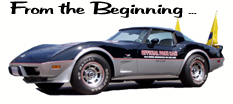|
IMS
Announcer Tom Carnegie Dies At 91
February
10, 2011, story and photos courtesy IMS
The mighty,
thundering voice of the Indianapolis Motor Speedway has been
silenced.
Tom Carnegie,
the legendary chief announcer for the IMS Public Address system
for an incredible 61 years, died Feb. 11 in the Indianapolis
suburb of Zionsville. He was 91.
Carnegie
served as the Public Address announcer at the Speedway from
1946-2006. He called 61 Indianapolis 500’s, 12 Brickyard
400’s and six United States Grands Prix for millions
of fans at IMS.
Carnegie’s
incredible baritone coined and developed such iconic phrases
as, “AND HEEEEEEE’S ON IT!” “HEEEEEERE’S
THE TIME AND SPEED REPORT!” and the classic “AAAAAAND,
IT’S A NEEEEEW TRACK RECORD!”
It is
fair to say Carnegie probably deserves more credit than any
other single human being for helping build the gigantic crowds
that were drawn to the track for qualifications three and
four decades ago. He developed his style through the mid-1950s
and pretty much had it perfected by the early 1960s, bellowing
the aforementioned phrases and others to the delight of the
crowd. He enjoyed tantalizing the attentive throng by “telegraphing”
a track record or a spectacular speed with setup lines like,
“YOU WON'T BELIEVE IT!” or, in the case of a run
in which the speeds were increasing with each lap, “AAAAAAND,
IT’S STILL GOING UP!”
Born in
Connecticut as the son of a Baptist minister, Carnegie grew
up aspiring to be an actor. But those hopes were dashed when
he was stricken with polio as a student in Missouri. He turned
his attention instead to the broadcasting of sporting events,
and his sense of the dramatic quickly came to the fore.
After
graduating from William Jewell College in Liberty, Mo., he
landed a job in 1942 at radio station WOWO in Fort Wayne,
Ind. Westinghouse in Pittsburgh owned WOWO and sister station
WGL, and the station manager suggested the name Tom Carnegie
would go well in the East since the name Carnegie was prominent
in Pittsburgh. So Carl Kenagy – Carnegie’s birth
name – became Tom Carnegie.
Fate
eventually led him to radio station WIRE in Indianapolis near
the end of World War II. He also wrote sports columns for
the Indianapolis Star. It was while he was “emceeing”
at a vintage car concourse just days before the 1946 “500”
that new track president Wilbur Shaw heard his work and invited
him to assist with the public address on Race Day. Carnegie
accepted and kept coming back for the next six decades.
Because
of his sense of the dramatic, and the fact that it had not
been possible for any spectator to see completely around the
massive facility, he enjoyed toying with the imagination of
the IMS crowd with lines like: “WHO WILL IT BE? WHO WILL
IT BE?” Or on a relatively peaceful qualifying day, while
waiting to see if a driver was or was not going to raise his
hand for a qualifying run, “Let’s wait and watch,”
with a little singsong rise and fall to the last word. This
would likely be followed up by, “Heeeeere he comes,”
delivered with an upward glissando for “here” and
a two-note singsong for “comes.”
Privately,
Carnegie became somewhat saddened in the 1990s when virtually
instant timing-and-scoring information became available to
the public via computers, followed by the installation of
large television screens around the track. He felt these innovations
could lessen the mystique. “It’s theater,”
he would philosophize, pointing up into the grandstands and
then chuckling over the memories of some of his more famous
calls from the days when the public was relying largely on
his commentary.
Perhaps
his favorite “call” came in the closing moments
of the 1967 Indianapolis 500 when Parnelli Jones had to drop
out with Andy Granatelli’s turbine after having led for
much of the day, setting the stage for A.J. Foyt to become
a three-time winner. Moments before Foyt was due to come through
Turn 4 for the final time, a multi-car accident took place
on the main straight, all but blocking the track. While cars
were spinning in every direction – and, unknown to Carnegie,
Foyt, with his incredible sixth sense, had already slowed
– Carnegie was bellowing, "HE SHOULD BE COMING INTO
SIGHT AT ANY MOMENT. WILL HE GET THROUGH? WILL HE GET THROUGH?
WHERE IS HE? WHERE IS HE?” What followed was the triumphant,
"THERE HE IS!!!"
Carnegie
never really wanted to quit. But he understandably found himself
tiring more easily upon entering his 80s. Realizing that the
dramatic finish to the 2006 "500" would be hard
to top – Sam Hornish Jr. seemingly came out of nowhere
to edge young Marco Andretti at the start/finish line –
Carnegie decided to call it a career in June 2006.
He would
continue to come to the track as a visitor during event times
and be besieged by race fans of all ages who wanted to share
their memories and thank him for his contributions.
His contributions
spread far beyond the Indianapolis Motor Speedway. He was
covering qualifications for the inaugural Ontario (Calif.)
500 in 1970 for what was then WFBM-TV (now WRTV), of which
he was the longtime sports director, when he was quickly pressed
into service.
Carnegie
actually travelled the circuit for a couple of years after
that, announcing all of the United States Auto Club national
championship races. He was a real friend to USAC, as well
as to the Speedway, never failing to show up for any kind
of press announcement over a period of many years and always
willing to interview a driver on camera about an upcoming
race.
He was
eventually to be inducted into a variety of Halls of Fame,
in the fields of both motor racing and broadcasting.
The impact
of Tom Carnegie has been immeasurable, and his work will never
be forgotten.
Carnegie
is survived by his wife, D.J., and children Blair, Charlotte
and Robert.
|



